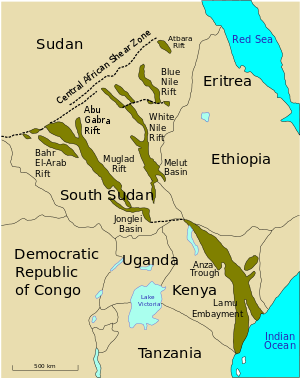Anza trough

Central African rifts: Anza trough to the southeast.
The Anza trough is a rift in Kenya that was formed in the Jurassic Period of the Mesozoic Era. The trough runs inland from the coast in the northwest direction.
The trough appears to be an aulacogen, a failed arm of a triple junction of a plate tectonics rift system, formed during the initial stretching phase when Gondwana was breaking up.[1] The rift was formed by the same forces that created the rift system in South Sudan, and connects those rifts to the Lamu embayment further to the south. The separation of the other two arms of the junction allowed India-Madagascar to separate from Africa.[2] The trough is now hidden by a cover of Quaternary sediments and volcanic rocks.[3]
References
- ↑ David B. Stone; S. K. Runcorn (1993). Flow and creep in the solar system: observations, modeling, and theory. Springer. p. 230. ISBN 0-7923-2148-0.
- ↑ L C Greene; D R Richards; R A Johnson (1991). "Crustal structure and tectonic evolution of the Anza rift, northern Kenya". Tectonophysics. 197 (2-4): 203–211. Bibcode:1991Tectp.197..203G. doi:10.1016/0040-1951(91)90041-P. Retrieved 2010-12-20.
- ↑ C.V. Reeves; F.M. Karanja; I.N. MacLeod (January 1987). "Geophysical evidence for a failed Jurassic rift and triple junction in Kenya". Earth and Planetary Science Letters. 81 (2-3): 299–311. Bibcode:1987E&PSL..81..299R. doi:10.1016/0012-821X(87)90166-X.
This article is issued from Wikipedia - version of the 6/9/2016. The text is available under the Creative Commons Attribution/Share Alike but additional terms may apply for the media files.